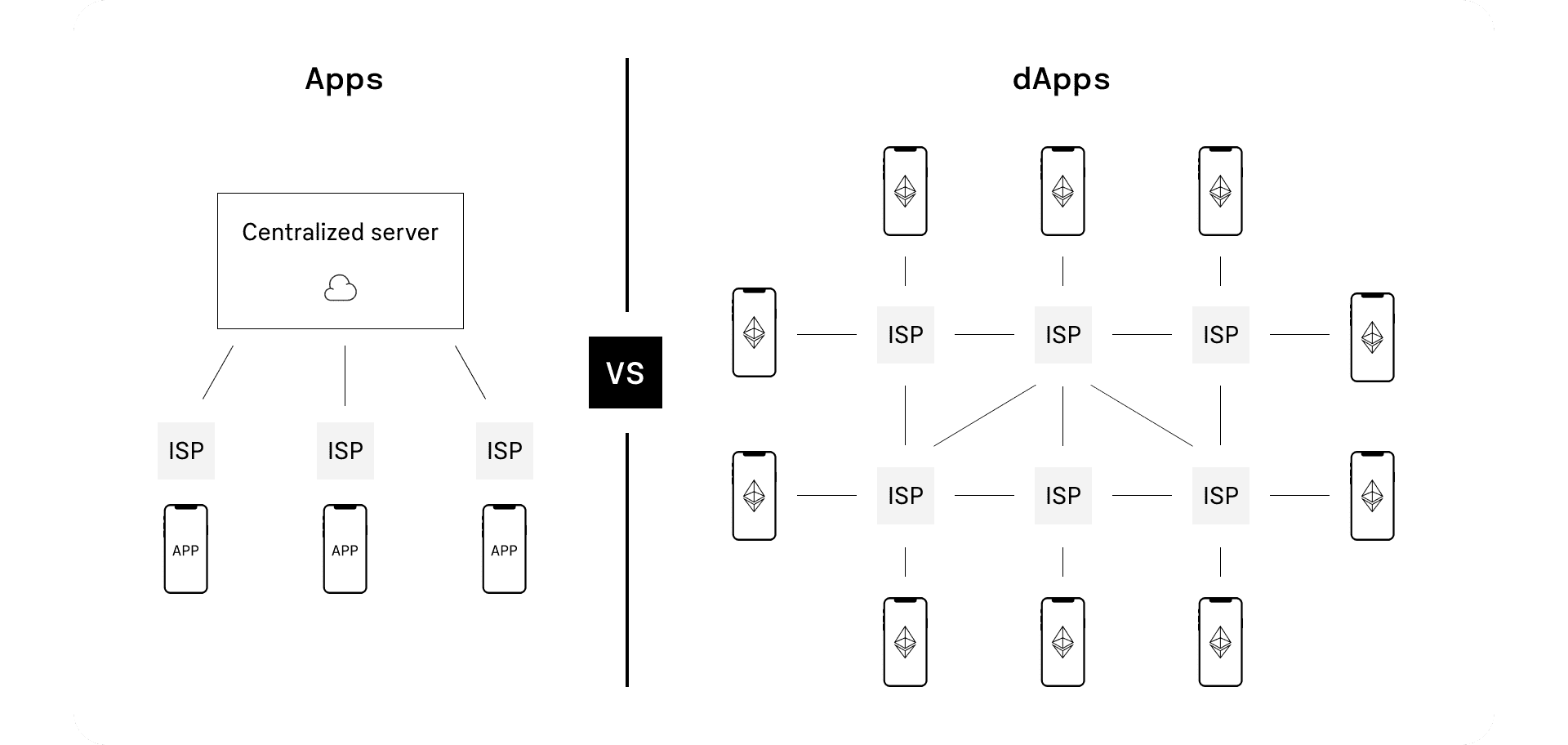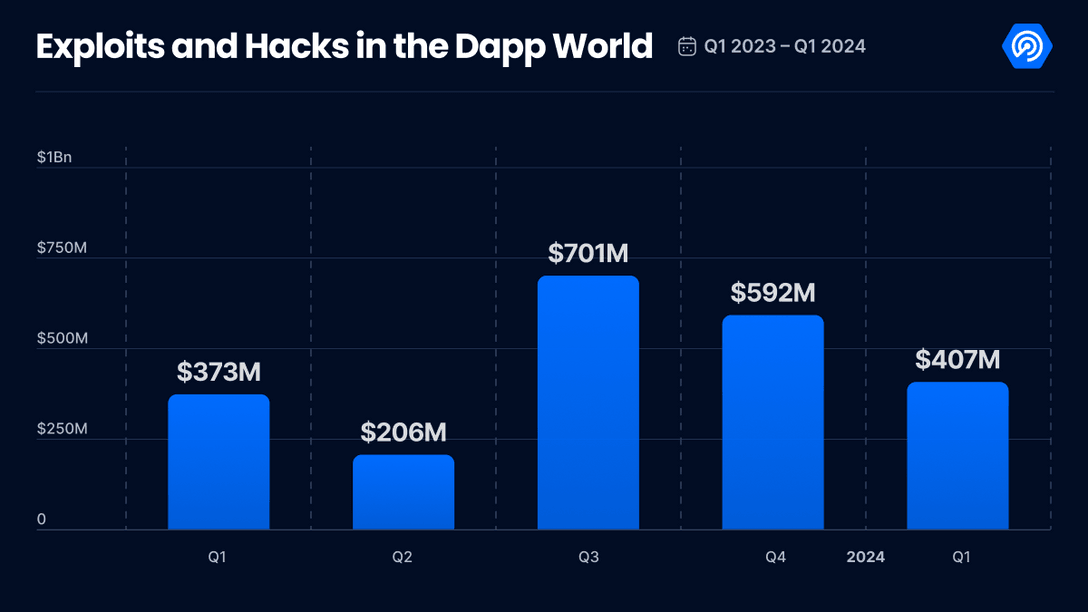What are decentralized apps (DApps)?

Decentralized applications, known as DApps, dApps, or Dapps, cut out the middleman in digital transactions. Unlike products owned and managed by companies, they are immune to censorship. DApps combine the benefits of a blockchain network with a familiar frontend. Here is our guide to this novel way of creating digital apps, their strengths, challenges, and prospects.
What is DApp (decentralized app)?
DApps may have user interfaces written in any programming language, and they resemble regular apps functionality-wise. Such applications can serve numerous industries, from gaming to social media. What makes them special is the decentralized networks they exist on.
DApps operate without an entity controlling them, beyond the purview of banks or other financial institutions. They have a peer-to-peer foundation, such as a blockchain or P2P platform. The General Theory of Decentralized Applications, DApps, a whitepaper by Johnston et al., suggests three crucial characteristics.
- Open-source code and autonomy (no centralized entity)
- Only public data and records (no central points of failure)
- Cryptographic token (security and rewards for contribution)
The DApp consensus mechanism, which defines token generation, may rely on Proof of work, Proof of stake, or both. According to the authors, their combination makes DApps more sustainable and resistant to 51% attacks — interference by entities controlling over half of the network. DApps may also have customized consensus models tailored to their purpose.
Decentralized applications (DApps) vs. centralized
A conventional digital app, be it Instagram or Uber, relies on a centralized computer system operated by its owner. This entity has power over the backend – the inner workings — of the product. Their servers host the application software, while users install a copy of the app on their devices.
Throughout user interactions, data travels back and forth — to and from the company's server. This results in convenience at the cost of privacy, as owners can access, use, and even sell this information. For example, they may know what products users prefer and how much they spend.

The way DApps work makes this inherent flaw impossible. Instead of a centralized server, their frontend makes calls to smart contracts resting on a peer-to-peer network, such as the Ethereum blockchain.
Decentralized network technology
With Web 3.0, users no longer have to sacrifice their privacy for usability. They can decide what information to share, who can access it, and for how long — for example, one may only submit data required for a loan. These safeguards, which rest on a smart contract foundation, prevent unauthorized access.
Yet not all P2P networks use crypto, and some of them have been around for decades. These decentralized services let multiple users consume, feed, or seed content, performing several functions simultaneously. Here are three prominent examples:
BitTorrent (the first client for uploading and downloading files via the BitTorrent protocol)
Tor (a browser based on onion routing, a P2P overlay network model allowing anonymous browsing)
Popcorn Time (open-source software that lets users download or stream different types of media)
In the crypto domain, DApps are built on top of blockchains — most often, the Ethereum network. As an environment for transactions, a blockchain network is public, open-source, decentralized, and free from single authority interference.
Users connect to peers directly after paying an amount of crypto to download and use the source code — smart contract. Instead of a central authority or a single computer, DApps do not require sharing personal information, which makes them inherently more secure.
Ethereum DApps and smart contracts
DAppRadar lists thousands of decentralized applications built on Ethereum, EOS, Polygon, and other blockchains. Ethereum's smart contract infrastructure facilitates rapid deployment of customized code for new DApps. Currently, this flexible platform leads the way with nearly 4,800 deployed DApps. The top three categories are:
Exchanges (Uniswap V2 and V3)
Marketplaces (OpenSea)
Programmable liquidity protocols (Balancer)
DeFi (CoW Swap and Sky, formerly Maker)

Vitalik Buterin's vision of a blockchain-based internet puts users in charge of their data. His concept for Ethereum stretches far beyond finance — to a decentralized way of life. Smart contracts are key to its realization. These automated and immutable if-then statements make intermediaries, centralized storage, and centralized control redundant.
Ethereum DApps use smart contracts deployed on Ethereum and the decentralized storage of the blockchain. Thanks to system accessibility, developers do not have to create new contracts from scratch. All applications work in an isolated fashion within the Ethereum Virtual Machine, so bugs in individual contacts may not disrupt the functioning of the blockchain.
Key advantages of DApps
Due to their backend code running on blockchains, DApps offer decentralized data storage and privacy protection. They cater to users who want to interact without fear of suppression. Here are the six biggest upsides to the DApp technology.
Enhancing user privacy
Accessing a DApp, be it a gaming app or an exchange, does not require submitting personal information. With no sensitive data stored and no central entity, the transacting parties always remain anonymous. DApps built on smart contracts are well-protected against identity theft.
No censorship
As DApps have no single point of failure, neither governments nor financial institutions nor individuals can easily control them. For example, a Twitter-like DApp residing on a blockchain may allow anyone to post messages that no one — including the app creators — can delete.
No downtime
Owing to P2P foundations, decentralized apps keep operating even if individual computers or network segments shut down. In the absence of centralized servers, there is no risk of attacks on physical devices. As a result, such networks are more secure than their centralized counterparts.
Open-source
The source code for any decentralized application is public. This openness encourages the global development and improvement of this ecosystem. Software developers can build better DApps with enhanced functionality and value.
Smart contracts
Smart contracts facilitate the integration of cryptocurrencies for basic P2P functions. DApps for decentralized finance are time and money savers — they make transactions nearly instant, with no or negligible costs. For instance, Valoraenables users to send money to anyone with gas fees of $0.001. Moreover, as every smart contract is immutable, verifiable, and autonomous, it is protected from interference.
Universal applications
DApps can be tailored to nearly any industry, from gaming to healthcare to file storage. Their familiar frontend and user experience complement the utility of a blockchain-based platform. DApps offer an innovative way to interact with applications as part of the global decentralization of information, or Web 3.0.
Drawbacks of DApps
Despite their benefits over centralized apps, DApps struggle to provide the same degree of flexibility. Their poor usability hinders mass adoption, and some products are purely experimental. DApps are improving as time goes on, but the industry is yet to resolve its biggest issues.
Scalability challenge
Smooth scalability is not a given, especially when a DApp needs significant computations. Network congestion and overload are possible consequences.
Lack of usability
Getting users to abandon well-established apps requires superior performance and user experience. DApps are not a download away – currently, they work in compatible browsers, and users send their crypto to a specific wallet and interact from there. This is a turnoff for non-tech savvy users. The frontend often leaves a lot to be desired, especially as centralized apps create an ease-of-use expectation.
Complicated modifications
Once the data and code for a DApp are published to the blockchain, changes become arduous. At the same time, any DApp is likely to need post-deployment enhancements and bug fixes. The Ethereum team acknowledges the maintenance problem.
For developers, conventional apps are faster to update. A corporation can tweak its app's backend or frontend code as it sees fit. DApp updates are slower as there is no centralized network or control. Even a minor fix requires majority consensus from the acting governance, which could take weeks.
Security risks
While smart contracts are immutable, they are also open-source. Malicious parties can review code to spot weaknesses for hacks and exploits. Security remains an issue.

Cybercrime accounted for $1.9 billion stolen from DApps in 2023, compared to $48 billion in 2022. However, incidents became 17.3% more frequent, highlighting vulnerabilities. In Q1 2024, $407 million was stolen in total.
In February 2024, a hacker stole $290 million from PlayDApp, a gaming and NFT platform, by minting 1.79 billion PLA tokens. The perpetrator then laundered the funds and rejected PlayDApp’s offer of a $1 million white hat reward.
Poly Network alone was exploited for $611 million in August 2021. In March 2022, Ronin bridge in the Axie Infinity game was hacked with $552 million stolen. Attacks on the cross-chain bridges (which transfer funds between blockchains), along with DeFi flash loan exploits, are on the rise, but social engineering is also common.
User base
As DApps need nodes, governance, and users, smooth operation requires a reasonably-sized user base. Compared to Web 2.0 apps, DApps have modest user numbers. This limitation affects the security (it usually depends on the audience size), interactions, and overall efficiency of the network. Furthermore, some DApps have inadequate user support.
Prospects of decentralized app (DApp) technology
DApps' advantages over traditional applications prevent centralized interference. Enhanced privacy, protection from censorship, and the flexibility of development attract many users in and beyond the crypto community.
That said, the industry is in its early stages, so it is yet to overcome its growing pains. DApps have numerous applications, from finance to social media, but the developers must successfully address their scalability challenges and security concerns.



